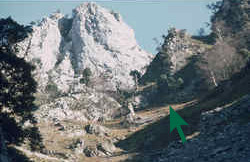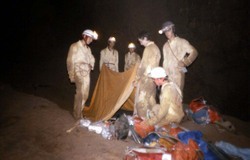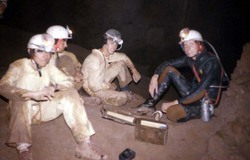

Introduction
Site list (GPS fixes) Walks (GPS tracks) Video clips Panoramas
Electronic projects:
Bat detector
Lamp tests
µ-controlled lamp
SEPIC-based lamp
ISP isolators
Making SMT boards
Expedition logs:
Spain 1973, 1974,
1975, 1976, 1977,
1979, 1982, 1983,
1985, 1986, 1987,
1988, 1989, 2000,
2001, 2002, 2003,
2004, 2005, 2006,
2007, 2008, 2009,
2010, 2011, 2012,
2013, 2014, 2015,
2016, 2017, 2018,
2019, 2020, 2021,
2022, 2023
Mexico
New England
Translation:
Name: Pozu del Infierno
Location: Deva Gorge, above Coto del Infierno
GPS: N43°16'28" W4°38'06" Alt. 310m (S.E.S.) or 264m (altimeter, 2001)
UTM: 30T 367.44 4792.80
Lambert: 5231 9637
Map: 56-II
Survey: In OUCC Proc 5 ».
Directions: Walk to the cave starts at northern end of Coto del (de El) Infierno, which is reached over a narrow bridge 📌 that crosses the Deva. The cave is around the ridge to the south, up a very steep ‘path’; in 2001 it took 90 minutes up to the cave; 45 minutes down.
Description: Impressive cave with huge chambers, etc.; over 2km long. Probably first explored by S.E.S. TALPS in 1969 ‘in the company of Sr. Caracol’.
From OUCC Proc 5 » (MFC): “‘A further visit would almost certainly yield new passages’ (3) – how often is this kind of statement met in expedition reports. However the writer had promised himself the trip, and so two years and two expeditions to the Picos later, a return visit was made to the La Hermida gorge in the company of Martin Laverty, Steve Newton and Bill Collis. After meeting a Spanish team from Barcelona, who were planning to resurvey the cave over the next few days, we sweated up the hillside and eventually found the entrance. A fairly direct route through the cave soon brought us to the previous limit of exploration.* An easy but cold duck was soon passed – this led to the beginning of a deep, wide lake winding off into the darkness. Not being equipped for swimming a retreat was made back out and down to the Spanish camp at Coto del Infierno. On discussing this find with the Spanish cavers it transpired that one of their members had stumbled on the lake while lost some three years before – but had been unable to find it again.
The next day saw Bill and Mike back at Coto del Infierno to guide the Spanish surveying team to the lake. After helping them carry their rucksacks, tents, dinghies etc. to the Talps gallery we eventually got to the lake. A fine swim led to a disappointing boulder choke. An Anglo-Español pushing attempt was unsuccessful but several new side passages were explored for some distance. Eventually we left and were well entertained by those Spaniards who were not camping inside the cave.”
*S.E.S. TALPS had explored and surveyed the cave up to this point about five years ago. This is 1km beyond the point described as the ‘limit of exploration’ in: SES Talps del Centro Excursionista de Valles, 1971, “Cavidades de la Zona de La Hermida (Santander)”, Cuadernos de Espeleologia 5-6, pp pp 231- 250.
Visits:
1973 – 6 trips by/with BUSS; see OmniBUSS 5 pp10–12.
1975 – trip with Spaniards to sifon
1975 – trip across lake to end, with Spaniards
1986 – stopped by second ramp (no rope)
2001 – good trip to Sala del Ríu (River Chamber)
Other:
(None.)


